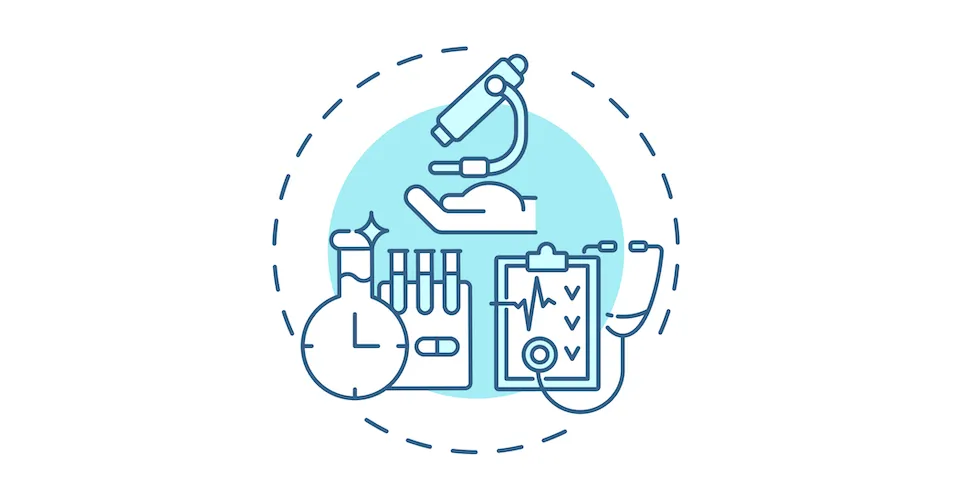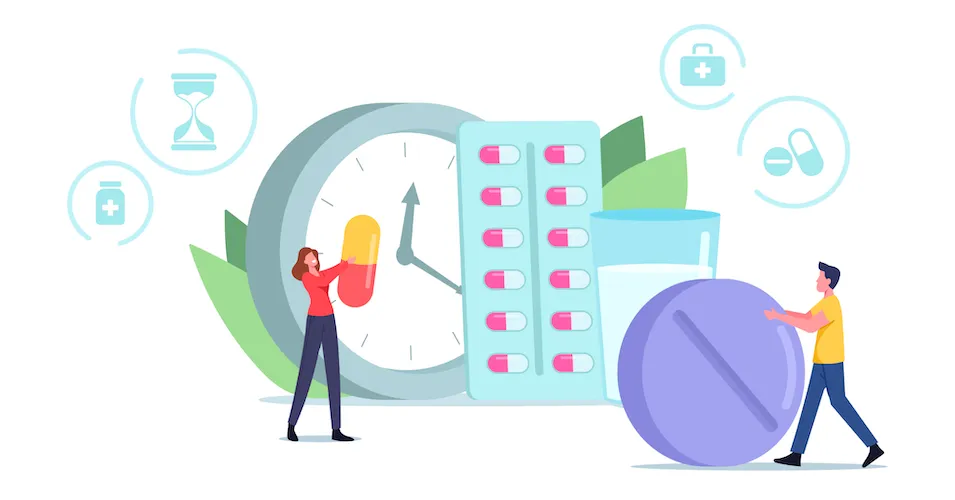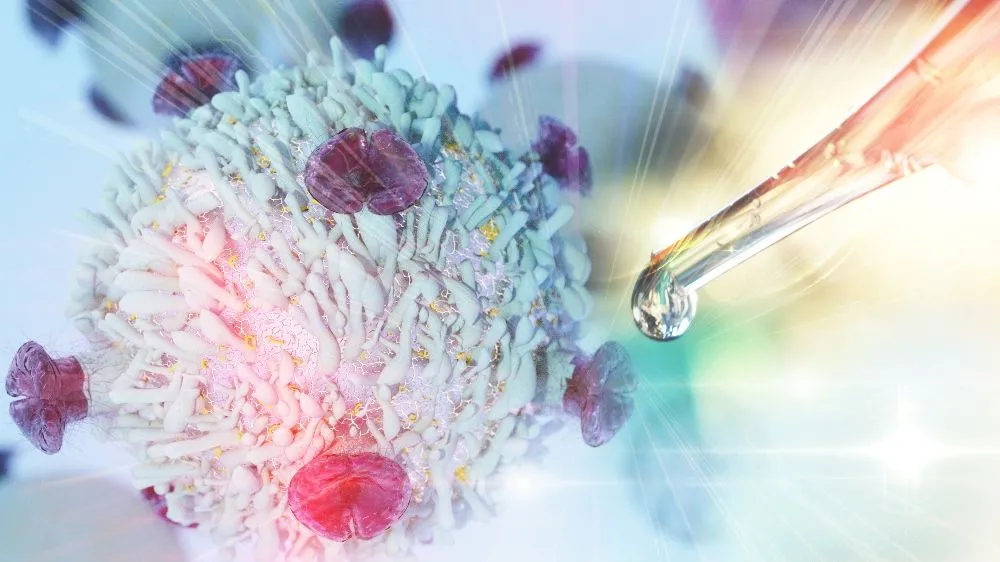Understanding R-CHOP: A Treatment Option for Follicular Lymphoma

Chemoimmunotherapy is a type of treatment often used to treat patients with lymphoma. The R-CHOP regimen is a kind of chemoimmunotherapy widely used in patients with B-cell non-Hodgkin lymphomas (NHL) and specifically to treat people with follicular lymphoma that have never been treated before. Alternatively, your doctor might also talk to you about initiating treatment with bendamustine.
What Does R-CHOP Mean?
R-CHOP is an acronym representing the combination of drugs used in this regimen:
- Rituximab – a monoclonal antibody that targets CD20, a protein found on B cells, including lymphoma cells.
- Cyclophosphamide – a chemotherapy drug that disrupts cancer cell growth.
- Hydroxydaunorubicin (doxorubicin) – a chemotherapy drug that is also known as Adriamycin and interferes with cancer cell growth.
- Oncovin (vincristine) – a chemotherapy drug that targets dividing cells, including cancer cells.
- Prednisone – a steroid that helps reduce inflammation and suppress the immune system, which can help with certain side effects.
How Does R-CHOP Work for Follicular Lymphoma?
R-CHOP combines the targeted action of rituximab with the cell-killing power of chemotherapy drugs. Rituximab attaches to the CD20 protein on lymphoma cells, making them targets for the immune system to destroy. The chemotherapy drugs in CHOP work in different ways to stop cancer cells from growing and dividing. Prednisone helps to manage side effects like nausea and allergic reactions and can also help inhibit the growth of lymphoma cells.
What Is R-CHOP Treatment Plan Like?
The R-CHOP regimen is typically given in cycles, with each cycle lasting 21 days. Some studies have used a 14-day cycle, but a 21-day cycle is the standard approach. The 21-day cycle typically consists of:
- Days 1-5: Treatment with rituximab, cyclophosphamide, doxorubicin, and vincristine, usually given through an IV infusion. Prednisone is taken orally during these days.
- Rituximab – infusion into the bloodstream over a few hours on Day 1
- Cyclophosphamide – infusion into the bloodstream or as a slow injection over around 30 minutes on Day 1
- Doxorubicin – infusion into the bloodstream or as a slow injection over around 30 minutes on Day 1
- Vincristine – infusion into the bloodstream over around 10 minutes on Day 1
- Prednisolone – orally on Days 1–5
- Days 6-21: Rest period, allowing your body to recover from the treatment.
Patients typically receive six 21-day cycles of R-CHOP, but the total number of cycles you'll need will depend on factors like the stage of your follicular lymphoma, your overall health, and how your body responds to treatment.
Older patients and/or patients with other diseases or conditions who can’t tolerate the intensive R-CHOP regimen may receive a lower dose version of R-CHOP, sometimes referred to as R-miniCHOP.
Important Considerations for Follicular Lymphoma
While R-CHOP can be effective for follicular lymphoma, it's important to remember that this type of lymphoma often grows slowly. Your doctor might recommend a "watch and wait" approach before starting treatment, especially if you don't have severe symptoms. Learn more about when it is indicated to start follicular lymphoma treatment with our previous webinar, Understanding Follicular Lymphoma with Dr. Sarah Rutherford.
What Are the Side Effects of R-CHOP?
The side effects of R-CHOP treatment can vary from patient to patient. More than 10% of patients experienced the following side effects at varying grades of seriousness:
- Reduced white blood cells with an increased risk of infection
- Anemia and blood clots
- Physical side effects and changes: easy bruising and bleeding, hair loss, changes to nails and skin, sore mouth, weight gain, numbness or tingling in fingers or toes
- Other symptoms include nausea and vomiting, swelling, headaches, diarrhea, constipation, fatigue, irritation of the bladder and difficulty urinating, red or pink urine, irritation of the stomach, sore mouth
- Allergic reactions during infusion, such as skin rash, itching, swelling, breathing difficulties, fever and chills
- Changes to the functioning of the heart or the liver
- Tumor lysis syndrome, a condition that can occur after chemotherapy caused by the breakdown of cancer cells, which can result in organ damage.
- Increased risk of developing secondary malignancies in the long term, also known as treatment-related malignancies, second cancers, or second primary cancers.
If you feel unwell during treatment, it may be a sign of an allergic reaction, and you should inform your medical team. If you experience symptoms of a heart attack or a blood clot, you should call emergency services.
Treatment with R-CHOP can increase your risk of infection
Due to a reduction in white blood cells during treatment, you may be more susceptible to infections, which can be serious. Contact your healthcare professionals immediately if you feel unwell or have a temperature above 99.5°F/37.5°C or below 96.8°F/36°C.
Key takeaways
- R-CHOP is a type of chemoimmunotherapy consisting of rituximab, cyclophosphamide, doxorubicin, vincristine, and prednisolone.
- Treatment usually involves six 21-day cycles, with 5 days of treatment and 16 days of rest.
- It is important to keep your healthcare team informed about any side effects you experience.
To continue reading about treatments for follicular lymphoma, explore all the free resources at HealthTree for Follicular Lymphoma. Sign up for our newsletter and join the HealthTree Foundation community!
follicular lymphoma newsletter
Sources:
Chemoimmunotherapy is a type of treatment often used to treat patients with lymphoma. The R-CHOP regimen is a kind of chemoimmunotherapy widely used in patients with B-cell non-Hodgkin lymphomas (NHL) and specifically to treat people with follicular lymphoma that have never been treated before. Alternatively, your doctor might also talk to you about initiating treatment with bendamustine.
What Does R-CHOP Mean?
R-CHOP is an acronym representing the combination of drugs used in this regimen:
- Rituximab – a monoclonal antibody that targets CD20, a protein found on B cells, including lymphoma cells.
- Cyclophosphamide – a chemotherapy drug that disrupts cancer cell growth.
- Hydroxydaunorubicin (doxorubicin) – a chemotherapy drug that is also known as Adriamycin and interferes with cancer cell growth.
- Oncovin (vincristine) – a chemotherapy drug that targets dividing cells, including cancer cells.
- Prednisone – a steroid that helps reduce inflammation and suppress the immune system, which can help with certain side effects.
How Does R-CHOP Work for Follicular Lymphoma?
R-CHOP combines the targeted action of rituximab with the cell-killing power of chemotherapy drugs. Rituximab attaches to the CD20 protein on lymphoma cells, making them targets for the immune system to destroy. The chemotherapy drugs in CHOP work in different ways to stop cancer cells from growing and dividing. Prednisone helps to manage side effects like nausea and allergic reactions and can also help inhibit the growth of lymphoma cells.
What Is R-CHOP Treatment Plan Like?
The R-CHOP regimen is typically given in cycles, with each cycle lasting 21 days. Some studies have used a 14-day cycle, but a 21-day cycle is the standard approach. The 21-day cycle typically consists of:
- Days 1-5: Treatment with rituximab, cyclophosphamide, doxorubicin, and vincristine, usually given through an IV infusion. Prednisone is taken orally during these days.
- Rituximab – infusion into the bloodstream over a few hours on Day 1
- Cyclophosphamide – infusion into the bloodstream or as a slow injection over around 30 minutes on Day 1
- Doxorubicin – infusion into the bloodstream or as a slow injection over around 30 minutes on Day 1
- Vincristine – infusion into the bloodstream over around 10 minutes on Day 1
- Prednisolone – orally on Days 1–5
- Days 6-21: Rest period, allowing your body to recover from the treatment.
Patients typically receive six 21-day cycles of R-CHOP, but the total number of cycles you'll need will depend on factors like the stage of your follicular lymphoma, your overall health, and how your body responds to treatment.
Older patients and/or patients with other diseases or conditions who can’t tolerate the intensive R-CHOP regimen may receive a lower dose version of R-CHOP, sometimes referred to as R-miniCHOP.
Important Considerations for Follicular Lymphoma
While R-CHOP can be effective for follicular lymphoma, it's important to remember that this type of lymphoma often grows slowly. Your doctor might recommend a "watch and wait" approach before starting treatment, especially if you don't have severe symptoms. Learn more about when it is indicated to start follicular lymphoma treatment with our previous webinar, Understanding Follicular Lymphoma with Dr. Sarah Rutherford.
What Are the Side Effects of R-CHOP?
The side effects of R-CHOP treatment can vary from patient to patient. More than 10% of patients experienced the following side effects at varying grades of seriousness:
- Reduced white blood cells with an increased risk of infection
- Anemia and blood clots
- Physical side effects and changes: easy bruising and bleeding, hair loss, changes to nails and skin, sore mouth, weight gain, numbness or tingling in fingers or toes
- Other symptoms include nausea and vomiting, swelling, headaches, diarrhea, constipation, fatigue, irritation of the bladder and difficulty urinating, red or pink urine, irritation of the stomach, sore mouth
- Allergic reactions during infusion, such as skin rash, itching, swelling, breathing difficulties, fever and chills
- Changes to the functioning of the heart or the liver
- Tumor lysis syndrome, a condition that can occur after chemotherapy caused by the breakdown of cancer cells, which can result in organ damage.
- Increased risk of developing secondary malignancies in the long term, also known as treatment-related malignancies, second cancers, or second primary cancers.
If you feel unwell during treatment, it may be a sign of an allergic reaction, and you should inform your medical team. If you experience symptoms of a heart attack or a blood clot, you should call emergency services.
Treatment with R-CHOP can increase your risk of infection
Due to a reduction in white blood cells during treatment, you may be more susceptible to infections, which can be serious. Contact your healthcare professionals immediately if you feel unwell or have a temperature above 99.5°F/37.5°C or below 96.8°F/36°C.
Key takeaways
- R-CHOP is a type of chemoimmunotherapy consisting of rituximab, cyclophosphamide, doxorubicin, vincristine, and prednisolone.
- Treatment usually involves six 21-day cycles, with 5 days of treatment and 16 days of rest.
- It is important to keep your healthcare team informed about any side effects you experience.
To continue reading about treatments for follicular lymphoma, explore all the free resources at HealthTree for Follicular Lymphoma. Sign up for our newsletter and join the HealthTree Foundation community!
follicular lymphoma newsletter
Sources:

about the author
Dylan Barrett
Dylan is a freelance medical writer based in Cork, Ireland. He previously worked in independent medical education while living in London and is now collaborating with HealthTree to develop resources for blood cancer patients. His background is in genetics, and he has a passion for innovative scientific research. In his spare time, he enjoys sports, traveling, and spending time with his family and friends.
More on Treatment Advances
Your Source for Expert Insights & Support in Non-Hodgkin Lymphoma.
By subscribing to the Healthtree newsletter, you'll receive the latest research, treatment updates, and expert insights to help you navigate your health.








